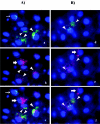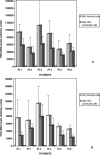Hepatitis C virus (HCV) and hepatitis B virus (HBV) can coinfect the same hepatocyte in the liver of patients with chronic HCV and occult HBV infection
- PMID: 16306629
- PMCID: PMC1316020
- DOI: 10.1128/JVI.79.24.15578-15581.2005
Hepatitis C virus (HCV) and hepatitis B virus (HBV) can coinfect the same hepatocyte in the liver of patients with chronic HCV and occult HBV infection
Abstract
In this work, we have shown that hepatitis C virus (HCV) and hepatitis B virus (HBV) can coexist in the same hepatocyte using double fluorescent in situ hybridization in liver biopsy samples from patients with chronic HCV infection with occult HBV infection. Digital image analysis of hybridization signals showed that the HBV DNA levels in coinfected hepatocytes were lower than those in cells infected only with HBV. This finding supports the hypothesis of inhibition of HBV replication by HCV. Furthermore, HCV RNA levels were lower in coinfected cells than in cells infected only with HCV, suggesting that HBV may also inhibit HCV replication.
Figures


References
-
- Bartenschlager R., and V. Lohmann. 2000. Replication of the hepatitis C virus. J. Gen. Virol. 81:1631-1648. - PubMed
-
- Cacciola, I., T. Pollicino, G. Squadrito, G. Cerenzia, M. E. Orlando, and G. Raimondo. 1999. Occult hepatitis B virus infection in patients with chronic hepatitis C liver disease. N. Engl. J. Med. 341:22-26. - PubMed
-
- Chen, D. S., G. C. Kuo, J. L. Sung, M. Y. Lai, J. C. Sheu, P. J. Chen, P. M. Yang, H. M. Hsu, M. H. Chang, C. J. Chen, L. C. Hahn, Q. L. Choo, T. H. Wang, and M. Houghton. 1990. Hepatitis C virus infection in an area hyperendemic for hepatitis B and chronic liver disease: the Taiwan experience. J. Infect. Dis. 162:817-822. - PubMed
-
- Chen, S. Y., C. F. Kao, C. M. Chen, C. M. Shih, M. J. Hsu, C. H. Chao, S. H. Wang, L. R. You, and Y. H. Lee. 2003. Mechanisms for inhibition of hepatitis B virus gene expression and replication by hepatitis C virus core protein. J. Biol. Chem. 278:591-607. - PubMed
-
- Dumoulin, F. L., A. von dem Bussche, J. Li, L. Khamzina, J. R. Wands, T. Sauerbruch, and U. Spengler. 2003. Hepatitis C virus NS2 protein inhibits gene expression from different cellular and viral promoters in hepatic and nonhepatic cell lines. Virology 305:260-266. - PubMed
Publication types
MeSH terms
Substances
LinkOut - more resources
Full Text Sources
Medical

